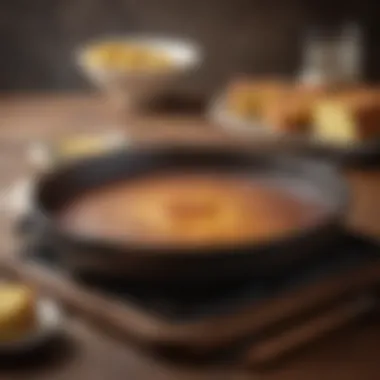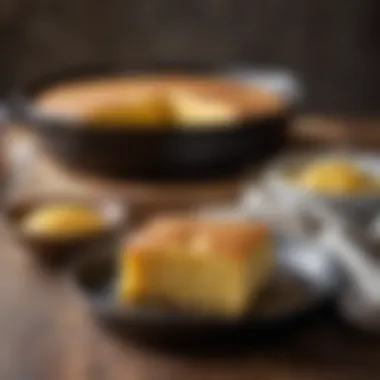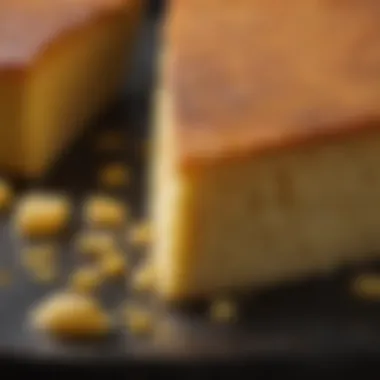The Cast Iron Cornbread Pan: Mastering a Kitchen Essential


Intro
The cast iron cornbread pan stands out as an essential kitchen utensil. Its significance goes beyond mere aesthetics; it embodies a rich history and offers unparalleled cooking advantages. This article seeks to explore the multifaceted nature of the cast iron cornbread pan, highlighting aspects such as its provenance, practical benefits, and care methods.
Understanding the value of this cookware can enhance one’s culinary experiences. This guide aims to equip readers with knowledge on how to choose, maintain, and fully utilize this pan in their cooking. The insights provided will be beneficial to both novice cooks and seasoned chefs, allowing them to expand their repertoire in the kitchen.
Recipe Highlight
Sweet Southern Cornbread
This recipe brings the timeless flavors of southern cuisine to your table. Sweet Southern Cornbread is a perfect accompaniment to stews and barbecues.
Essential Ingredients:
- 1 cup cornmeal
- 1 cup all-purpose flour
- 1/3 cup sugar
- 1 tablespoon baking powder
- 1/2 teaspoon salt
- 1 cup milk
- 1/4 cup melted butter
- 2 large eggs
Estimated Preparation Time: 15 minutes
Servings: 8 servings
Step-by-Step Instructions
- Preheat your oven to 400°F (200°C). Place your cast iron cornbread pan in the oven to heat.
- In a large bowl, mix the cornmeal, flour, sugar, baking powder, and salt.
- In another bowl, whisk together the milk, melted butter, and eggs until well combined.
- Gradually blend the wet ingredients into the dry mixture. Stir gently until just combined; do not overmix.
- Carefully remove the heated pan from the oven. Pour in a thin layer of melted butter, coating the bottom and sides.
- Pour the cornbread batter into the pan, spreading it evenly. Bake for 20-25 minutes or until the surface is golden brown and a toothpick comes out clean.
- Let it cool for a few minutes before slicing and serving.
Helpful Techniques
Utilizing a hot pan gives a crisp texture to the crust. Ensure the oven is adequately preheated for best results.
Insider Advice
A common mistake is overmixing the batter. This can lead to a dense texture. Mixing only until combined will yield fluffier cornbread.
Variations and Substitutions
For those looking to adjust the recipe:
- Alternative Sweeteners: Use honey or maple syrup instead of sugar for a different flavor.
- Add-ins: Consider adding jalapeños for spice, or cheese for richness.
- Gluten-Free Option: Substitute all-purpose flour with almond flour or a gluten-free blend.
Time-Saving Cooking Tips
To make cooking easier:
- Prep Ingredients Ahead: Measure and mix dry ingredients ahead of time, so they are ready to go when it’s time to bake.
- Use a Food Processor: This can quickly combine wet ingredients, making preparation more efficient.
- Cook Multiple Batches: Consider preparing two cornbreads simultaneously to last for the week.
Nutritional Information
Each serving contains approximately:
- Calories: 180
- Carbohydrates: 25g
- Proteins: 4g
- Fats: 7g
This recipe provides a good amount of carbohydrates, which can offer energy. Additionally, it contains protein from the eggs and is versatile for various meal plans, including vegetarian diets.
"The cast iron cornbread pan is not just a cooking tool; it is a gateway to enhancing culinary skills and family gatherings."
As the layers of flavor and texture build in your cooking, the cast iron cornbread pan undoubtedly emerges as a vital component in any kitchen.
Intro to Cast Iron Cookware


The world of cooking is vast, with a plethora of cookware options available, yet few can rival the enduring appeal of cast iron. This section serves as an introduction to cast iron cookware, setting the stage for discussions around the cast iron cornbread pan. The significance of cast iron arises not only from its performance in the kitchen but also from its rich history and unique qualities.
Definition and Characteristics
Cast iron cookware includes pots, pans, and other cooking vessels made primarily from iron. It is renowned for its exceptional heat retention and even heat distribution. These characteristics are crucial in ensuring that food cooks uniformly, which is particularly important in baking and frying.
Cast iron pans are often pre-seasoned with oil, creating a natural non-stick surface that improves with each use. This surface becomes more robust over time, allowing for better cooking performance. The weight of cast iron cookware is another defining factor. While it can be heavier than alternatives, this heft contributes to its heat retention qualities, enhancing the cooking experience.
Historical Context
The history of cast iron cookware dates back hundreds of years. Its origins can be traced to ancient China in the 5th century. The material gained popularity in Europe during the 18th century due to its durability and ability to withstand high heat.
In early American kitchens, cast iron cookware became a staple. It was practical, versatile, and easily transferable from stovetop to oven. During the 19th and early 20th centuries, cast iron items were often passed down through generations, each piece telling a story of family gatherings and daily life. Today, this cookware is experiencing a resurgence as modern cooks appreciate its unique cooking qualities and timeless nature.
The Unique Qualities of a Cast Iron Cornbread Pan
The cast iron cornbread pan is not merely a cooking vessel; it embodies a legacy of craftsmanship and culinary tradition. This pan facilitates baking cornbread that is both flavorful and perfectly cooked, thanks to its distinct properties. Understanding these unique qualities is essential for any cook looking to enhance their kitchen experience. Some characteristics to consider include the ability to uniformly distribute heat, the durability of the material, and its natural non-stick surface that improves with use.
Even Heat Distribution
One of the most significant benefits of using a cast iron cornbread pan is its ability to distribute heat evenly. This is crucial for baking. When the pan is heated on a stovetop or in an oven, its mass helps to absorb and retain heat, ensuring that every part of the cornbread cooks at the same rate. Unlike other materials, such as aluminum or non-stick coatings, which can have hot spots or uneven cooking, a cast iron pan provides consistent results. This not only enhances the texture of the cornbread but also contributes to achieving that lovely golden crust loved by many.
Durability and Longevity
Durability is another hallmark of cast iron cookware, and the cornbread pan is no exception. Properly cared for, a cast iron pan can last for generations. It is resistant to warping and scratching unlike many types of modern cookware, making it a reliable choice for daily use. Even if it gets minor blemishes or imperfections, the stalwart nature of cast iron means that it can often be restored with a little care. Investing in a high-quality cast iron cornbread pan is not just a purchase; it is a long-term commitment that rewards cooks with an enduring kitchen ally.
Natural Non-Stick Surface
The evolution of the non-stick surface in a cast iron cornbread pan is noteworthy. When seasoned properly, cast iron develops a patina that acts as a natural non-stick coating. This requires minimal oil or butter for cooking, promoting healthier cooking methods. Over time, the surface improves with usage, reflecting a natural enhancement that synthetic coatings simply cannot replicate. This lifeline to the authentic cooking process often yields flavors that processed materials miss entirely, underscoring the connection between the cook and their craft.
"A well-seasoned cast iron pan is a chef's best friend, providing both practicality and tradition in every recipe."
Understanding these qualities enhances the appreciation for the cast iron cornbread pan. It is not simply about cooking cornbread; it is about engaging with a rich history of cooking that elevates the culinary experience. The unique properties of a cast iron cornbread pan make it an essential piece of cookware in both modern and traditional kitchens.
Choosing the Right Cast Iron Cornbread Pan
Choosing the right cast iron cornbread pan is essential for achieving the best cooking results. The right pan contributes significantly to the flavor and texture of cornbread, impacting its rise and crispiness. Various factors must be taken into consideration when selecting a pan, including size, shape, and brand. Understanding these aspects will help you make an informed decision that suits your cooking needs and preferences.
Size Considerations
Size is one of the most crucial factors when selecting a cast iron cornbread pan. Different sizes will yield different proportions of cornbread. A standard 10-inch pan often serves well for most recipes, providing enough space for rising while ensuring even cooking. However, if one is preparing for a gathering or family meal, opting for a larger pan may be beneficial.
Another important aspect to consider is the portion size. Smaller pans, such as 6-inch or 8-inch options, are ideal for personal meals or when trying a new recipe. Keep in mind that larger sizes may require adjustments in baking time or temperature. Cooking in an oversized pan might result in overcooked edges while leaving the interior undercooked. Thus, always consult your recipe for specific guidance regarding pan size to achieve perfectly baked cornbread.
Shape Variations
Cast iron cornbread pans come in various shapes, including round, square, and even specialty designs like muffin or skillet shapes. Each shape influences the cooking experience and final appearance of the cornbread.
- Round pans often provide a traditional look. The heat distribution is usually consistent, which is crucial for achieving a uniform crust.
- Square pans can be more practical for easy serving and slicing, especially when preparing larger batches.
- Specialty shapes add a creative touch to your presentation. Muffin shapes, for instance, are great for portion control and are visually appealing.
When choosing a shape, consider your personal style and how you intend to serve the cornbread. Shape may also affect cooking time, so ensure to account for this in your baking process.
Brand Reputations and Quality
The brand and quality of a cast iron cornbread pan can greatly affect your cooking results and overall satisfaction. Not all cast iron cookware is created equal. Some brands have established a reputation for durability and performance. Brands like Lodge and Le Creuset are well-regarded for their attention to detail and robust materials. These brands offer various types of pans, ensuring that there is something suitable for every cook.
When selecting a brand, evaluate user reviews and consider the pan’s warranty. A good warranty indicates the brand's confidence in their product. Look for customer feedback on heat retention, seasoning quality, and ease of cleaning. High-quality cast iron cookware is an investment, and ensuring you make a wise choice will pay off in the culinary results you achieve.
"Investing in a quality cast iron cornbread pan reaps rewards in flavor and longevity."


Preparing the Cast Iron Cornbread Pan for Use
Preparing a cast iron cornbread pan for use is a pivotal process that ensures the cookware performs optimally. Understanding how to prepare the pan not only enhances cooking experience but also prolongs its life. This section will outline the key steps necessary for seasoning, cleaning, and proper storage of the pan.
Seasoning the Pan
Seasoning is the process of treating the surface of the cast iron with oil to create a non-stick coating. This is crucial for achieving a perfect cornbread texture while also preventing rust.
- Selecting Oil: Use a high smoke point oil such as flaxseed oil or vegetable oil. Avoid oils that can become sticky over time.
- Application: Clean the pan with warm, soapy water and rinse thoroughly. Dry it completely using a towel. Then, pour a thin layer of oil into the pan and use a cloth or paper towel to spread it evenly over the interior surface.
- Heating: Preheat your oven to a temperature between 375°F and 450°F. Place the oiled pan upside down on the top rack of the oven. This allows excess oil to drip away, preventing a gooey buildup.
- Baking Time: Let the pan bake for at least an hour. After this, turn off the oven and allow the pan to cool inside the oven to ensure the oil bonds effectively.
"Properly seasoned cast iron not only prevents sticking but also helps in developing the flavors of your dishes."
Cleaning and Maintenance
Regular cleaning and maintenance of your cast iron cornbread pan are essential to keep its non-stick layer intact and avoid flavor contamination.
- Avoid Soap: Using soap or abrasive scrubbers can strip the seasoning. Instead, wash the pan with hot water and a stiff brush immediately after use. For stubborn residue, use coarse kosher salt as a scrub.
- Dry Thoroughly: After washing, always dry the pan completely on low heat to prevent rust. Moisture is the enemy of cast iron.
- Re-oiling: After each cleaning, apply a very thin layer of oil to maintain the seasoning. A little goes a long way. This is especially important if the pan has not been used for a while.
Storage Tips
Proper storage can significantly extend the life of your cast iron cornbread pan.
- Avoid Storage in Damp Places: Always store the pan in a dry place. Avoid areas that may attract moisture, as this leads to rusting.
- Place a Paper Towel Inside: When stacking your cast iron pan with other cookware, place a paper towel between them. This will absorb moisture and protect the surface.
- Use a Lid or Cover: If your pan has a lid, using it can prevent dust accumulation. If not, a cotton cloth can serve as a simple cover.
Overall, taking the time to prepare and maintain your cast iron cornbread pan ensures that it will provide excellent cooking performance for many years.
Cooking with a Cast Iron Cornbread Pan
Cooking with a cast iron cornbread pan is a significant aspect to understand when exploring this versatile cookware. The ability to create a perfectly baked cornbread is not merely dependent on the recipe but also on the pan used. A cast iron pan provides characteristics that elevate the cooking experience, influencing both the texture and flavor of your cornbread.
One of the primary benefits of using a cast iron cornbread pan is its superior heat retention and distribution. This means that once the pan reaches the desired temperature, it maintains that heat more effectively than other materials. This is essential for achieving a golden, crisp crust on the cornbread while keeping the center moist and fluffy. Furthermore, the natural non-stick qualities of a well-seasoned pan enhance the baking process, allowing the cornbread to release effortlessly.
In addition, the cooking experience itself can expand when one explores recipes beyond standard cornbread. The following sections detail an essential recipe, variations, and alternative uses for a cast iron cornbread pan.
Essential Cornbread Recipe
To prepare an unforgettable cornbread, five fundamental ingredients are required:
- Cornmeal - The base of the recipe, providing that characteristic cornbread texture.
- Flour - All-purpose flour adds structure.
- Baking Powder - This ingredient ensures the cornbread rises adequately during baking.
- Eggs - Eggs contribute moisture and binding.
- Milk - Whole milk or buttermilk can add richness.
A straightforward method could be:
- Preheat your oven to 425°F (220°C). Place the cast iron pan inside while it heats up.
- Mix 1 cup of cornmeal, 1 cup of all-purpose flour, 2 teaspoons of baking powder, and a pinch of salt in a bowl.
- In a separate container, whisk together 2 eggs and 1 cup of milk. Mix into the dry ingredients.
- Add in 1/4 cup of melted butter; blend everything well.
- Carefully remove the hot pan from the oven, grease it lightly with oil, then pour in your batter.
- Bake for 20-25 minutes until the edges are golden and a toothpick comes out clean.
The result will be a wonderfully textured cornbread, ideal as a side dish or standalone snack.
Variations on Traditional Cornbread
Once you master the basic recipe, consider experimenting with variations. Some possibilities include:
- Cheddar and Jalapeño: Adding shredded cheddar cheese and diced jalapeños creates a savory twist.
- Sweet Cornbread: Incorporating honey or maple syrup can enhance the sweetness, making it a delightful pairing with chili.
- Herbed Cornbread: Mixing in fresh herbs like rosemary or thyme creates a distinctive flavor profile suitable for gourmet meals.
These variations can personalize your cornbread experience, introducing different textures and flavors that excite the palate.
Alternative Uses Beyond Cornbread
Cast iron cornbread pans are not limited to cornbread alone. Their versatile nature allows for multiple culinary applications:


- Skillet Dishes: You can use it for baking frittatas or egg dishes.
- Grilled Cheese: The pan can also work for making perfectly crispy grilled cheese sandwiches.
- Casseroles: Experiment with baking various casseroles for added flavor and texture.
By delving into these alternative uses, one can realize that a cast iron cornbread pan offers extensive possibilities, making it an invaluable piece of cookware in any kitchen.
Health and Nutritional Aspects
The topic of health and nutritional aspects plays a significant role in understanding the cast iron cornbread pan's contribution to cooking. This section focuses on the benefits associated with using cast iron cookware, particularly when it comes to iron intake and the management of cooking oils. These factors not only affect the quality of the food one prepares but also impact overall health.
Iron Intake from Cast Iron Cookware
One of the well-known benefits of cast iron cookware is its ability to increase iron levels in food. When food is cooked in a cast iron cornbread pan, small amounts of iron can leach into the food, especially when cooking acidic dishes. This can be beneficial for individuals who may have iron deficiencies, including some women and vegetarians.
Research indicates that using cast iron cookware can contribute to dietary iron intake. This is particularly relevant for those concerned about anemia or low iron levels. Foods with high acidity, such as tomatoes or even cornbread batter, can enhance this leaching effect. However, it is important to note that the amount of iron leached can vary depending on factors such as food type, cooking time, and the age of the cookware.
Another point to consider is that cast iron does not provide excessive iron overdoses in healthy individuals. The body typically regulates iron levels effectively, making cast iron a safe option for most people.
"Cooking with cast iron cookware can positively influence dietary iron intake, providing health benefits while enhancing traditional recipes."
Management of Cooking Oils
Cooking oils play a crucial role in preparing food, especially in frying or baking. Using a cast iron cornbread pan requires consideration of the type of oil used. Some oils have a better smoke point than others, impacting the flavor of your cornbread as well as its healthfulness.
When cooking with cast iron, it is often recommended to choose oils with high smoke points like canola, grapeseed, or avocado oil. These oils can withstand higher temperatures without breaking down and releasing harmful compounds. Conversely, oils like olive oil, while healthy, may burn at higher temperatures and alter the taste of your dish.
Managing oils is also related to seasoning your cast iron pan. A well-seasoned pan can naturally create a non-stick surface, reducing the need for excessive oil. This can foster healthier cooking practices, such as reducing fat intake.
It is also vital to be mindful of how often the oil is reused in cooking. Repeated heating of the same oil can lead to the formation of harmful compounds. Thus, ensuring fresh oil is substituted regularly is a good practice to maintain health and flavor integrity while cooking.
Sustainability and Environmental Impact
The conversation around sustainability is increasingly relevant in today's cooking environment. The cast iron cornbread pan is not only a useful kitchen tool but also an exemplar of sustainable cookware. This section will delve into the longevity of cast iron cookware and the implications of reducing special-coated cookware in a sustainable lifestyle.
Longevity of Cast Iron
Cast iron cookware, including cornbread pans, boasts an extraordinary lifespan. When properly maintained, a cast iron pan can last for generations. This durability significantly contributes to sustainability, as it reduces the need for frequent replacements. Many users find that their cast iron pans improve with age, developing an enhanced cooking surface through repeated seasoning, or oil application.
- Consider the following aspects of longevity with cast iron:
- Minimal Waste: Unused, broken, or discarded pans contribute to landfill waste. Longer-lasting cookware helps combat this issue.
- Cost-Effective: While the upfront cost of cast iron pans may be higher, their lifespan offsets initial investment, providing financial savings in the long run.
- Heritage Cooking: Users may pass down cast iron pans, creating a connection through food and family tradition.
This longevity aligns with sustainable practices by promoting the use of a single item over many years or even decades. People are encouraged to choose quality over quantity when it comes to their kitchen essentials.
Reduction of Special-Coated Cookware
In recent years, special-coated cookware has become popular. However, many of these products, like non-stick pans, can pose environmental concerns. The manufacturing processes often involve materials that may not be safe or sustainable. By opting for cast iron, a more conscious choice emerges.
Some key considerations about reduced special-coated cookware include:
- Fewer Chemicals: Most cast iron pans are free from chemical coatings, making them a safer option for cooking.
- Recyclability: Once cast iron pans reach the end of their use, they can often be recycled, unlike many specialized coatings that complicate recycling processes.
- Health Benefits: Reducing the amount of special-coated cookware decreases exposure to potentially harmful chemicals, contributing positively to public health.
"Choosing cast iron over special-coated cookware is not only a preference for cooking; it’s a statement about commitment to the environment and our health."
The End
The conclusion serves as a significant part of this article, encapsulating the essence of what has been discussed about the cast iron cornbread pan. This cookware item not only displays a rich history but also offers unique benefits that encompass cooking efficiency, health considerations, and sustainability. For food lovers, cooks, and housewives, understanding these elements is crucial.
In summary, the cast iron cornbread pan is a versatile tool in any kitchen. Its exceptional heat retention and distribution bring out the best flavors in cooking. Furthermore, it has been shown that using cast iron can support a healthy iron intake, which is particularly beneficial in today's diet. Finally, the article emphasizes the long-lasting nature of cast iron products, mitigating the need for frequent replacements, ultimately reducing waste.
Summary of Key Points
- Heat Distribution: Cast iron pans evenly distribute heat, minimizing hot spots.
- Durability: With proper care, these pans can last generations, becoming a family heirloom.
- Health Benefits: Cooking with cast iron can increase dietary iron intake, important for overall health.
- Sustainability: Choosing a cast iron pan reduces reliance on non-recyclable products or those with special coatings that may contribute to environmental waste.
- Diverse Use: Beyond cornbread, these pans are suitable for a variety of recipes, enhancing culinary versatility.
Final Thoughts on the Cast Iron Cornbread Pan
In final analysis, the cast iron cornbread pan stands out as a fundamental cooking tool for anyone interested in effective and sustainable cooking practices. Its long-standing reputation is well-deserved, stemming from its reliable performance and culinary advantages. By investing in a quality cast iron pan, you are not just acquiring a piece of cookware but adopting a method of cooking that honors tradition, promotes health, and encourages sustainable practices. The insights provided in this article aim to empower both novice and experienced cooks to make informed decisions about their kitchen tools. Embrace the versatility and enduring quality of a cast iron cornbread pan; it promises to elevate your culinary experience.







